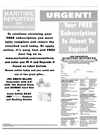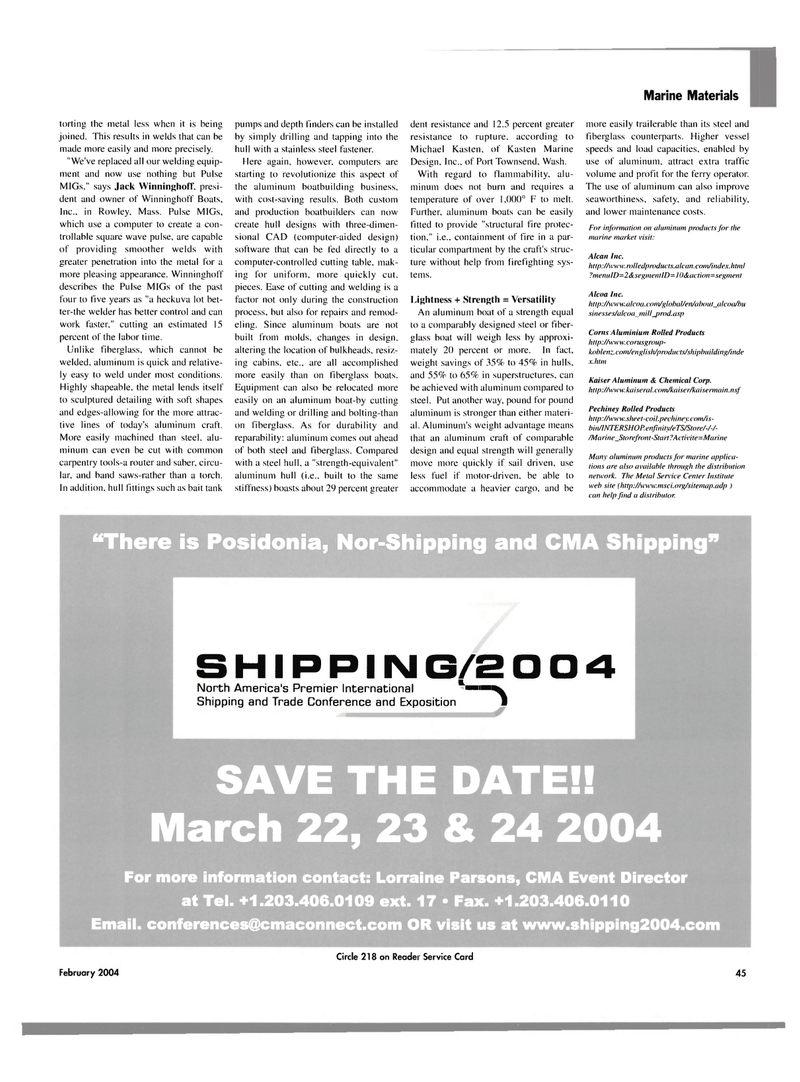
Page 50: of Maritime Reporter Magazine (February 2004)
The Tanker Yearbook: ATB Edition
Read this page in Pdf, Flash or Html5 edition of February 2004 Maritime Reporter Magazine
Marine Materials dent resistance and 12.5 percent greater resistance to rupture, according to
Michael Kasten. of Kasten Marine
Design, Inc., of Port Townsend, Wash.
With regard to flammability, alu- minum does not burn and requires a temperature of over 1,000° F to melt.
Further, aluminum boats can be easily fitted to provide "structural fire protec- tion." i.e.. containment of fire in a par- ticular compartment by the craft's struc- ture without help from firefighting sys- tems. more easily trailerable than its steel and fiberglass counterparts. Higher vessel speeds and load capacities, enabled by use of aluminum, attract extra traffic volume and profit for the ferry operator.
The use of aluminum can also improve seaworthiness, safety, and reliability, and lower maintenance costs.
For information on aluminum products for the marine market visit:
Alcan Inc. http://www.rolleclproducts.alccin.com/index.html ?menuID=2&segmentID=10&action=segment torting the metal less when it is being joined. This results in welds that can be made more easily and more precisely. "We've replaced all our welding equip- ment and now use nothing but Pulse
MIGs," says Jack Winninghoff, presi- dent and owner of Winninghoff Boats,
Inc., in Rowley. Mass. Pulse MIGs, which use a computer to create a con- trollable square wave pulse, are capable of providing smoother welds with greater penetration into the metal for a more pleasing appearance. Winninghoff describes the Pulse MIGs of the past four to five years as "a heckuva lot bet- ter-the welder has better control and can work faster," cutting an estimated 15 percent of the labor time.
Unlike fiberglass, which cannot be welded, aluminum is quick and relative- ly easy to weld under most conditions.
Highly shapeable, the metal lends itself to sculptured detailing with soft shapes and edges-allowing for the more attrac- tive lines of today's aluminum craft.
More easily machined than steel, alu- minum can even be cut with common carpentry tools-a router and saber, circu- lar, and band saws-rather than a torch.
In addition, hull fittings such as bait tank pumps and depth finders can be installed by simply drilling and tapping into the hull with a stainless steel fastener. flere again, however, computers are starting to revolutionize this aspect of the aluminum boatbuilding business, with cost-saving results. Both custom and production boatbuilders can now create hull designs with three-dimen- sional CAD (computer-aided design) software that can be fed directly to a computer-controlled cutting table, mak- ing for uniform, more quickly cut, pieces. Ease of cutting and welding is a factor not only during the construction process, but also for repairs and remod- eling. Since aluminum boats are not built from molds, changes in design, altering the location of bulkheads, resiz- ing cabins, etc., are all accomplished more easily than on fiberglass boats.
Equipment can also be relocated more easily on an aluminum boat-by cutting and welding or drilling and bolting-than on fiberglass. As for durability and reparability: aluminum comes out ahead of both steel and fiberglass. Compared with a steel hull, a "strength-equivalent" aluminum hull (i.e.. built to the same stiffness) boasts about 29 percent greater
Lightness + Strength = Versatility
An aluminum boat of a strength equal to a comparably designed steel or fiber- glass boat will weigh less by approxi- mately 20 percent or more. In fact, weight savings of 35c/c to 45r^ in hulls, and 55'/c to 65f/r in superstructures, can be achieved with aluminum compared to steel. Put another way, pound for pound aluminum is stronger than either materi- al. Aluminum's weight advantage means that an aluminum craft of comparable design and equal strength will generally move more quickly if sail driven, use less fuel if motor-driven, be able to accommodate a heavier cargo, and be
Alcoa Inc. http://www.alcoa.com/global/en/ahout_alcoa/hu sinesses/alcoa_mill._prod.asp
Corns Aluminium Rolled Products http://www.corusgroup- kohlenz.com/english/products/shiphuilding/inde x.htm
Kaiser Aluminum <6 Chemical Corp. http://www.kaiseral.com/kaiser/kaisermain.nsf
Pechiney Rolled Products http://www.sheet-coil.pechiney.com/is- bin/lNTERSHOP.enfinity/eTS/Store/-/-/- /Marine_Storefront-Start?Activite=Marine
Many aluminum products for marine applica- tions are also available through the distribution network. The Metal Serx ice Center Institute web site (http://www.msci.org/sitemap.adp ) can help find a distributor. "There is Posidonia, Nor-Shipping and CMA Shipping"
SHIPPING SO
North America's Premier International * ^
Shipping and Trade Conference and Exposition 1 04
SAVE THE DATE!!
March 22, 23 & 24 2004
For more information contact: Lorraine Parsons, CMA Event Director at Tel. +1.203.406.0109 ext. 17 • Fax. +1.203.406.0110
Email, [email protected] OR visit us at www.shipping2004.com
Circle 218 on Reader Service Card
February 2004 45

 49
49

 51
51
